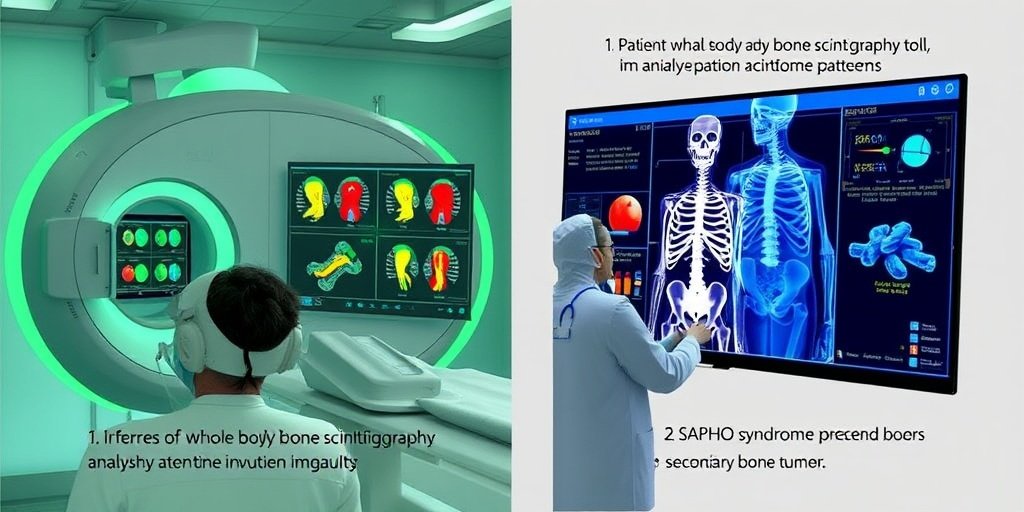⚡ Quick Summary
This multicenter study utilized machine learning to differentiate between SAPHO syndrome and secondary bone tumors (SBT) using whole-body bone scintigraphy (WBBS). The developed model achieved a remarkable accuracy of 88.3% and an AUC of 0.957 in external validation, showcasing its potential as a reliable diagnostic tool.
🔍 Key Details
- 📊 Dataset: 1,193 patients (593 with SAPHO syndrome, 600 with SBT)
- ⚙️ Techniques: LASSO regression, logistic regression, random forest
- 🏆 Performance: Training AUC 0.934, Testing AUC 0.929, Accuracy 88.3%
- 🔍 Significant predictors: Specific bones and joints for each condition
🔑 Key Takeaways
- 🤖 Machine learning effectively distinguishes between SAPHO syndrome and SBT.
- 📈 High diagnostic accuracy was achieved with an AUC of 0.957 in external validation.
- 🦴 Key predictors for SBT include the pelvis, femur, and thoracic vertebrae.
- 🦵 SAPHO syndrome is indicated by involvement of the sacroiliac joints and anterior ribs 1st-5th.
- 💡 The study highlights the importance of WBBS in diagnosing these conditions.
- 🌍 Multicenter approach enhances the reliability of the findings.
- 📅 Published in: Sci Rep, 2025; 15:18651.
- 🔗 DOI: 10.1038/s41598-025-99690-6

📚 Background
SAPHO syndrome is a complex inflammatory disorder characterized by both bone and skin manifestations. Diagnosing this condition can be challenging due to its overlapping features with secondary bone tumors (SBT). Whole-body bone scintigraphy (WBBS) is a common diagnostic tool, but distinguishing between these two entities remains a significant clinical challenge. This study aims to leverage machine learning techniques to improve diagnostic accuracy and provide clearer insights into the patterns of bone and joint involvement in these conditions.
🗒️ Study
Conducted across multiple centers, this study included a total of 1,193 patients diagnosed with either SAPHO syndrome or SBT. The researchers employed various machine learning techniques, including LASSO regression, logistic regression, and random forest, to identify significant risk factors and develop a robust diagnostic model. The study’s design allowed for a comprehensive analysis of WBBS findings, focusing on the unique patterns associated with each condition.
📈 Results
The machine learning model demonstrated impressive performance metrics, achieving a training AUC of 0.934 and a testing AUC of 0.929. The final model, which utilized 15 manually selected terms, yielded an overall accuracy of 88.3%, with precision and recall both at 88.7% and 88.3%, respectively. In external validation, the model maintained its reliability with an AUC of 0.957, a Youden index of 0.806, sensitivity of 0.820, and specificity of 0.986.
🌍 Impact and Implications
The findings from this study have significant implications for clinical practice. By utilizing machine learning to analyze WBBS data, healthcare professionals can achieve a more accurate and timely diagnosis of SAPHO syndrome and SBT. This advancement not only enhances patient care but also reduces the risk of misdiagnosis, leading to better treatment outcomes. The integration of such technologies into routine diagnostic processes could pave the way for improved healthcare delivery in the future.
🔮 Conclusion
This study highlights the transformative potential of machine learning in the field of diagnostic medicine. By effectively distinguishing between SAPHO syndrome and secondary bone tumors, the developed model serves as a valuable tool for clinicians. As we continue to explore the capabilities of AI and machine learning in healthcare, the future looks promising for achieving greater diagnostic accuracy and improving patient outcomes.
💬 Your comments
What are your thoughts on the use of machine learning in diagnosing complex conditions like SAPHO syndrome and SBT? We would love to hear your insights! 💬 Please share your comments below or connect with us on social media:
Machine learning based differential diagnosis of SAPHO syndrome and secondary bone tumors using whole body bone scintigraphy.
Abstract
SAPHO syndrome is an inflammatory disorder with bone and cutaneous manifestations, for which whole-body bone scintigraphy (WBBS) is frequently used in diagnosis. The WBBS findings of SAPHO syndromes and secondary bone tumors (SBT) have overlapping features, posing diagnostic challenges. In this multicenter study, we aim to identify different bone and joint involvement patterns between the two disease entities through multiple methods to build machine-learning models and explore interpretable variables. The study included 1,193 patients, of which 593 were diagnosed with SAPHO syndrome and 600 with SBT. LASSO regression, logistic regression, and random forest techniques were applied in the training set to identify significant risk factors. Manual management and other methods were evaluated in the validation set to identify the top-performing model and the most interpretable terms. The study developed a model using 15 manually selected terms and multiple machine learning techniques, which demonstrated high diagnostic accuracy in the G1 dataset for (training AUC 0.934, testing AUC 0.929, accuracy = 88.3%, precision = 88.7%, Recall = 88.3%, F1 score = 0.882). The model was compared with logistic regression and random forest models and showed consistent results in the G2 dataset for external validation (AUC 0.957, Youden index = 0.806, sensitivity = 0.820, specificity = 0.986). The pelvis, femur, and ribs (excluding anterior ribs 1st-5th) and thoracic vertebrae 1st-8th were significant predictors of SBT, whereas the sacroiliac joints, sternum, foot, anterior ribs 1st-5th, and clavicle were indicative of SAPHO. This study assesses the effectiveness of WBBS terms in identifying SBT from SAPHO syndrome and utilizes machine learning to help screen features for patients. The final model demonstrates its dependability, providing a valuable tool for accurate and timely diagnosis.
Author: [‘Jiang H’, ‘Liu A’, ‘Cao Y’, ‘Lin Z’, ‘Jiang H’, ‘Liu S’, ‘Peng Q’, ‘Wu X’, ‘Liu Y’, ‘Yu X’, ‘Wei M’, ‘Pan Y’, ‘Li C’, ‘Ying Z’]
Journal: Sci Rep
Citation: Jiang H, et al. Machine learning based differential diagnosis of SAPHO syndrome and secondary bone tumors using whole body bone scintigraphy. Machine learning based differential diagnosis of SAPHO syndrome and secondary bone tumors using whole body bone scintigraphy. 2025; 15:18651. doi: 10.1038/s41598-025-99690-6